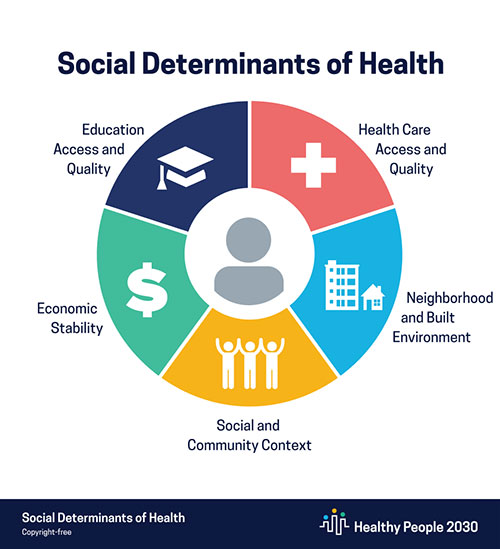The social determinants of health (SDOH) include your economic, family, and community stability, the neighborhood and built environment, your educational attainment, your access to healthcare, and its quality. Several studies have looked at disparities in care and care outcomes and have found that while only 3% might be due to your neighborhood or built environment, 47% was due to socioeconomic factors. Your health behavior accounted for 34%, and the remaining 16% was related to healthcare itself.
 Take a moment to consider those factors, remembering that these percentages explain the differences in outcomes, not the outcomes themselves. As a physician, I have mixed feelings over the 16% attributable to healthcare – the good news is that for all the writing about disparities, the impact may not be as significant as we think; the bad news is that our healthcare is more reparative than preventative. That a third of the disparities in our health come from our behavior is both biologically plausible and, to be honest, a bit lower than I anticipated. The contribution of the remaining factors, those SDOHs, makes sense in that they reflect our environment – it’s “tooth and claw,” fanged or defanged. While our behavior is entangled with those social determinants, in some senses, they are the most readily modified.
Take a moment to consider those factors, remembering that these percentages explain the differences in outcomes, not the outcomes themselves. As a physician, I have mixed feelings over the 16% attributable to healthcare – the good news is that for all the writing about disparities, the impact may not be as significant as we think; the bad news is that our healthcare is more reparative than preventative. That a third of the disparities in our health come from our behavior is both biologically plausible and, to be honest, a bit lower than I anticipated. The contribution of the remaining factors, those SDOHs, makes sense in that they reflect our environment – it’s “tooth and claw,” fanged or defanged. While our behavior is entangled with those social determinants, in some senses, they are the most readily modified.
Money Talks, the Rest Walks
As with most changes, impacting SDOHs begins with measurement. In 2015, enter the Z code.
For all of its complexity, healthcare in the US is driven by codes. The International Classification of Disease version 10 (ICD-10) has codes for all possible conjoiners of disease and also provides a classification of the varying elements of SDOH, e.g.,
- Z56 – Problems related to employment and unemployment
- Z59 – Problems related to housing and economic circumstances
- Z60 – Problems related to social environment
- Z72 – Problems related to lifestyle
While ICD-10 disease codes are required for billing, Z codes generate information, not revenue. A typical study of the use of Z coding by hospitals documents that they are used in 2% or 1.4% of admissions; other studies have documented that SDOH information is more frequently found (12%) in the unstructured notes within the electronic health record recorded by all members of the healthcare team, physicians, nurses, and social workers.
Researchers have posited any number of reasons for the abysmal utilization of Z codes.
- Physicians are already overwhelmed with documentary functions, so adding another may be one straw too many for our healthcare camels. In those instances where Z codes are documented, they are usually germane to the problem at hand. This is especially true for mental health issues where one of the SDOHs can be a precipitating factor.
- Z-codes are not as automated into the workflow of EHRs as are diagnostic codes. As I have suggested before, the EHRs document is for billing, not care.
- Z-codes are not reimbursed.
We could implement additional screening tools, but that would further overwhelm the healthcare team; we could pay for Z codes, but if our experience with Medicare Advantages upcoding of diagnosis is any guide, an avalanche of questionable Z codes would follow. Or we might let the new shiny object, artificial intelligence, do the heavy lifting.
The latest “triumph” of AI over humans is a report on how well a large language model (LLM), the same basis as ChatGPT and the others, could identify SDOHs in electronic health records. Using a small dataset of 800 notes from 770 patients, various LLMs were asked to identify the presence and absence of employment status, housing issues, transportation issues, parental and marital status, and social support – all significant SDOHs. Two researchers graded those same notes to determine what is usually referred to as the “ground truth” in these studies. SDOH mentions were rare, the largest in the area of marital status (0.3%); the LLMs were looking for needles in the proverbial haystack.
They did quite well, identifying upwards to 98% of the SDOHs mentioned in the free text written by any healthcare team member (that would include social workers). The researchers concluded:
“Our findings highlight the potential of large LMs to improve real-world data collection and identification of SDoH from the EHR. …in the future, these models could improve our understanding of drivers of health disparities by improving real-world evidence and could directly support patient care by flagging patients who may benefit most from proactive resource and social work referral.”
The keywords in that quote are potential and in the future. They have demonstrated that LLMs can find the information, but the bigger hurdle is that the information isn’t necessarily being collected. To data dive, the healthcare system must identify the “role” responsible for collecting the data – when everyone is responsible, no one is responsible. That will be easier if the data is collected from our freeform writing than from adding more checkboxes and drop downs and then codified as Z codes by AI rather than asking any member of an already overwhelmed health system to do more with no more resources. The alternative is to pay for the data, which can be very profitable for the data provider. A cost-benefit analysis would ultimately be needed to see if the cost to the taxpayer was a fair tradeoff with reductions in the disparity of health outcomes.
Source: Large language models to identify social determinants of health in electronic health records Nature Digital Medicine DOI: 10.1038/s41746-023-00970-0




